Dissertation: Impact of Structure and Culture on Tesco's Success
VerifiedAdded on 2023/01/19
|37
|11369
|92
Report
AI Summary
This dissertation analyzes the impact of organizational structure and culture on the success of Tesco, a multinational grocery and general merchandising company. The study explores the significance of organizational structure in its functioning, the role of culture in achieving success, and the influence of both factors on Tesco's performance. The research includes a literature review, a detailed methodology section outlining the research process, approach, strategy, and instruments used, followed by data analysis, discussion, and interpretation of findings. The dissertation addresses research questions regarding the importance of organizational structure, the role of culture, and their combined impact, culminating in conclusions, recommendations, and suggestions for further research. The introduction provides background information on the research topic and organization, research rationale, questions, and aims, setting the stage for an in-depth examination of Tesco's organizational dynamics and their effects on business outcomes. The study aims to provide insights into how organizational structure and culture can be optimized to enhance business success.
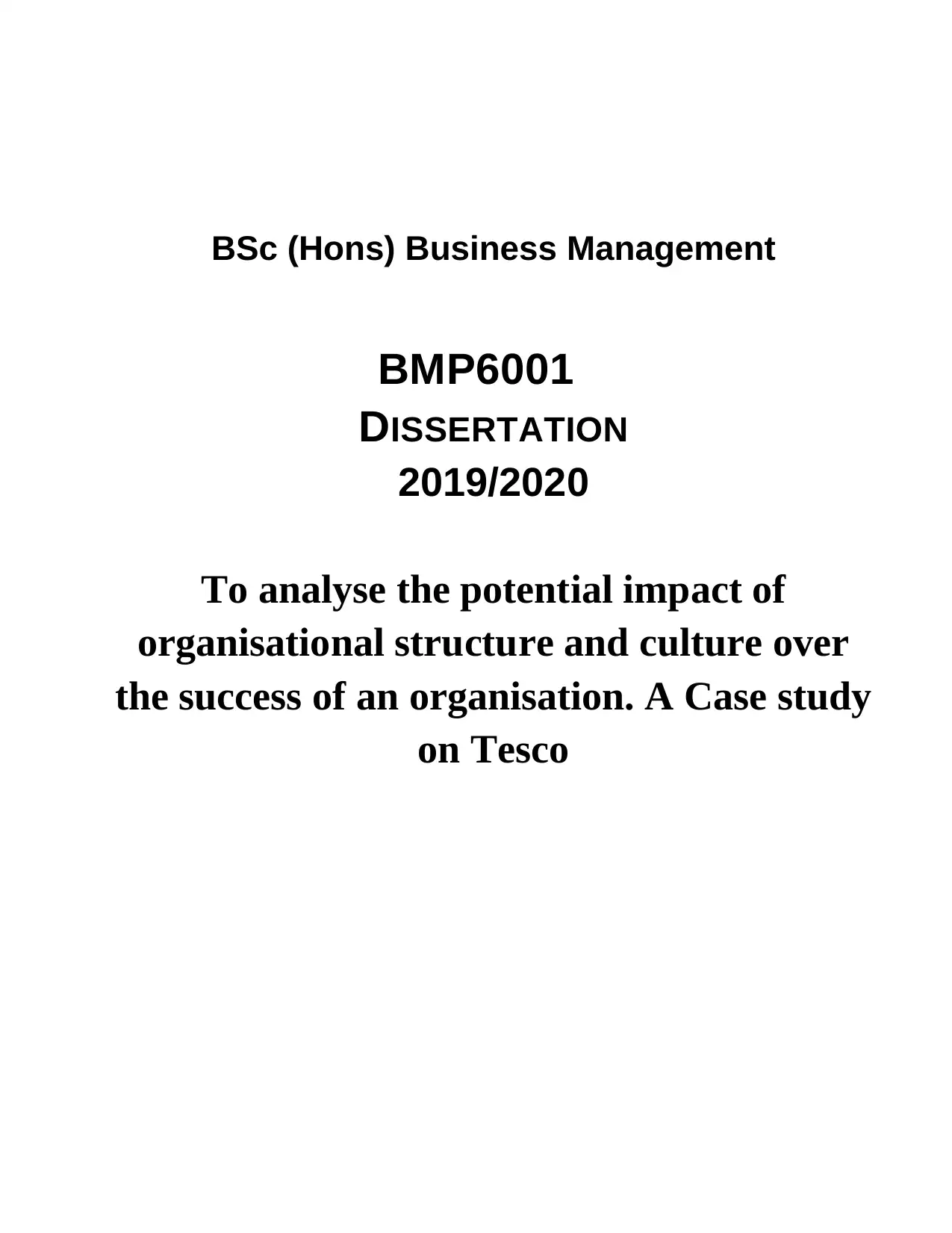
BSc (Hons) Business Management
BMP6001
DISSERTATION
2019/2020
To analyse the potential impact of
organisational structure and culture over
the success of an organisation. A Case study
on Tesco
BMP6001
DISSERTATION
2019/2020
To analyse the potential impact of
organisational structure and culture over
the success of an organisation. A Case study
on Tesco
Paraphrase This Document
Need a fresh take? Get an instant paraphrase of this document with our AI Paraphraser
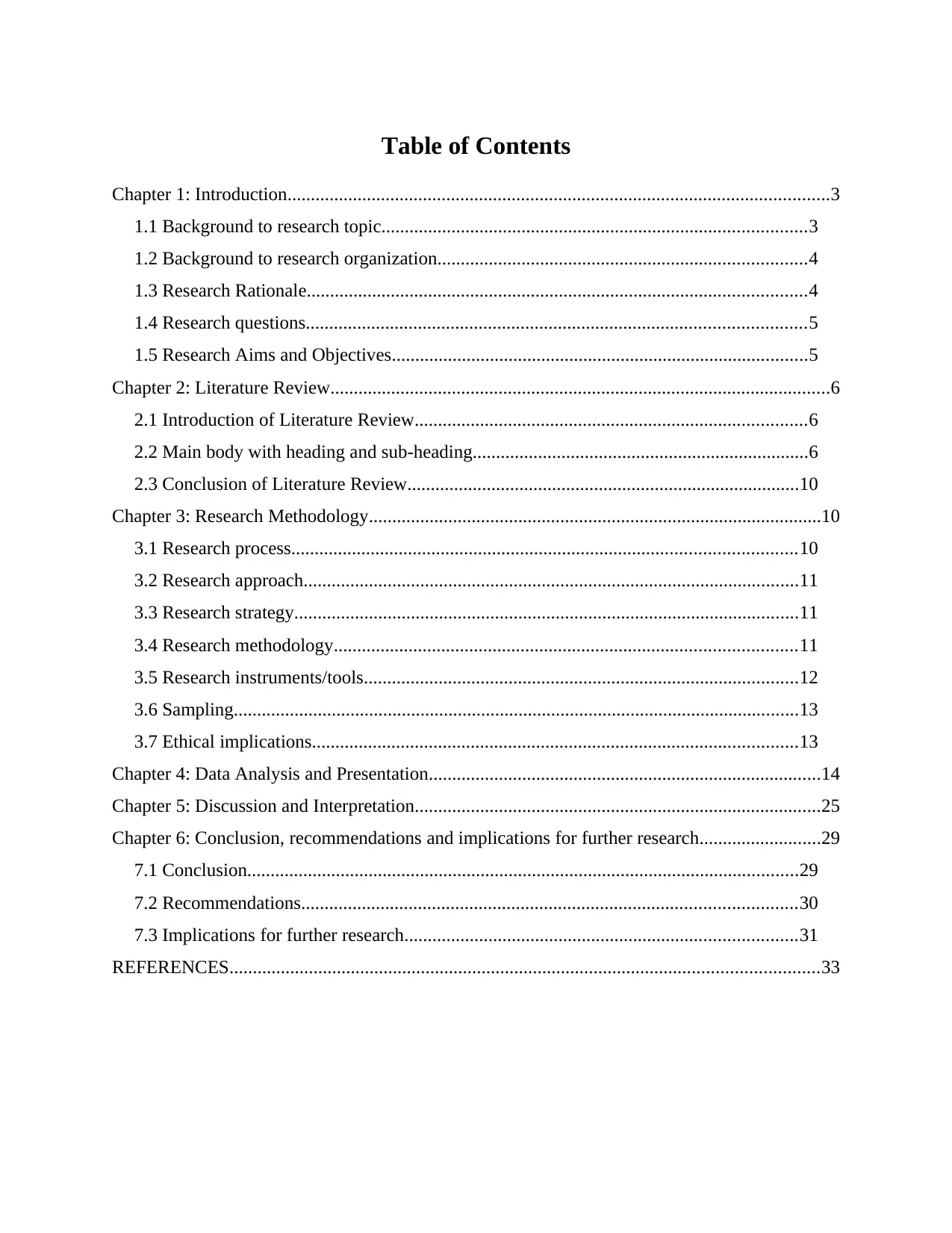
Table of Contents
Chapter 1: Introduction....................................................................................................................3
1.1 Background to research topic...........................................................................................3
1.2 Background to research organization...............................................................................4
1.3 Research Rationale...........................................................................................................4
1.4 Research questions...........................................................................................................5
1.5 Research Aims and Objectives.........................................................................................5
Chapter 2: Literature Review...........................................................................................................6
2.1 Introduction of Literature Review....................................................................................6
2.2 Main body with heading and sub-heading........................................................................6
2.3 Conclusion of Literature Review....................................................................................10
Chapter 3: Research Methodology.................................................................................................10
3.1 Research process............................................................................................................10
3.2 Research approach..........................................................................................................11
3.3 Research strategy............................................................................................................11
3.4 Research methodology...................................................................................................11
3.5 Research instruments/tools.............................................................................................12
3.6 Sampling.........................................................................................................................13
3.7 Ethical implications........................................................................................................13
Chapter 4: Data Analysis and Presentation....................................................................................14
Chapter 5: Discussion and Interpretation.......................................................................................25
Chapter 6: Conclusion, recommendations and implications for further research..........................29
7.1 Conclusion......................................................................................................................29
7.2 Recommendations..........................................................................................................30
7.3 Implications for further research....................................................................................31
REFERENCES..............................................................................................................................33
Chapter 1: Introduction....................................................................................................................3
1.1 Background to research topic...........................................................................................3
1.2 Background to research organization...............................................................................4
1.3 Research Rationale...........................................................................................................4
1.4 Research questions...........................................................................................................5
1.5 Research Aims and Objectives.........................................................................................5
Chapter 2: Literature Review...........................................................................................................6
2.1 Introduction of Literature Review....................................................................................6
2.2 Main body with heading and sub-heading........................................................................6
2.3 Conclusion of Literature Review....................................................................................10
Chapter 3: Research Methodology.................................................................................................10
3.1 Research process............................................................................................................10
3.2 Research approach..........................................................................................................11
3.3 Research strategy............................................................................................................11
3.4 Research methodology...................................................................................................11
3.5 Research instruments/tools.............................................................................................12
3.6 Sampling.........................................................................................................................13
3.7 Ethical implications........................................................................................................13
Chapter 4: Data Analysis and Presentation....................................................................................14
Chapter 5: Discussion and Interpretation.......................................................................................25
Chapter 6: Conclusion, recommendations and implications for further research..........................29
7.1 Conclusion......................................................................................................................29
7.2 Recommendations..........................................................................................................30
7.3 Implications for further research....................................................................................31
REFERENCES..............................................................................................................................33
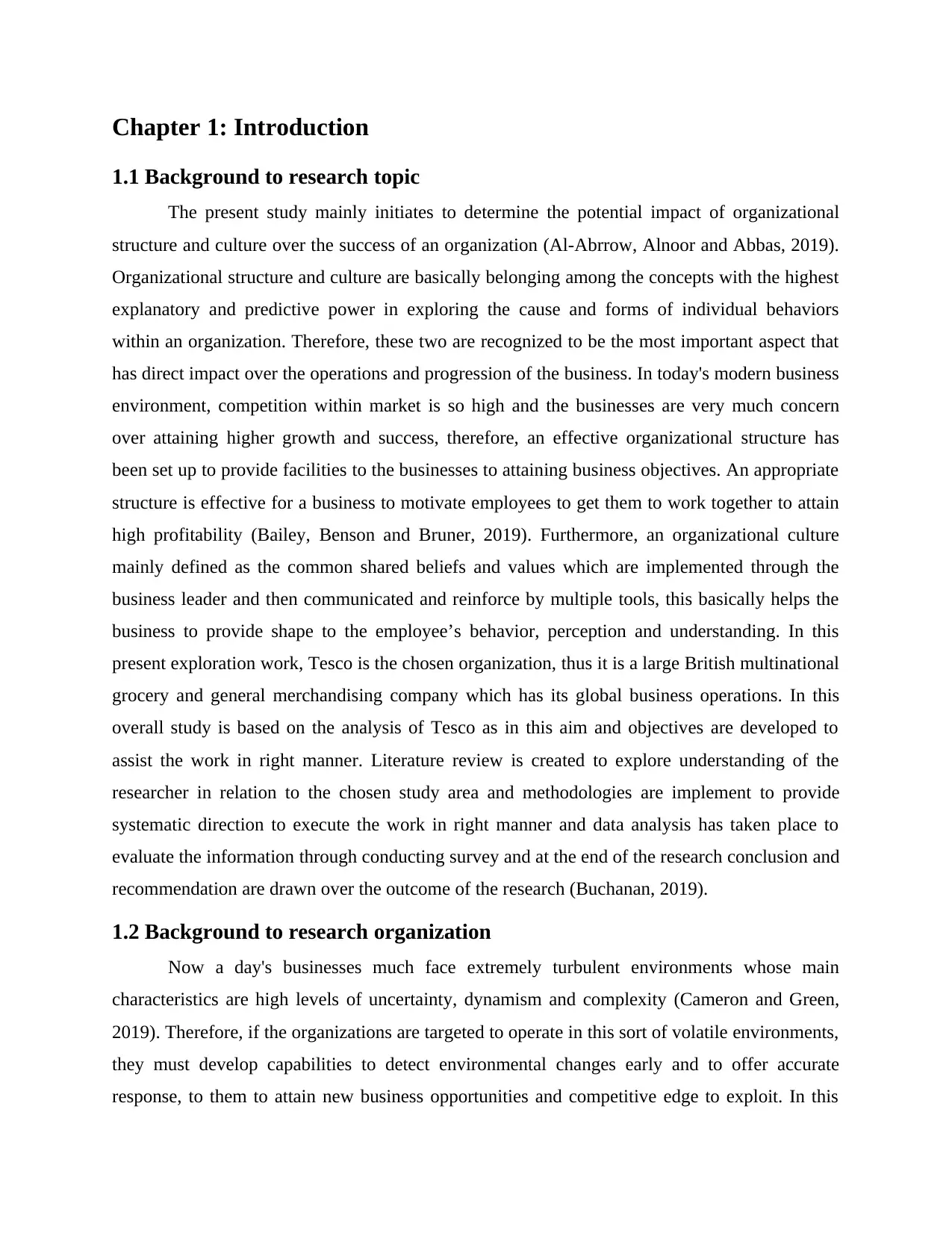
Chapter 1: Introduction
1.1 Background to research topic
The present study mainly initiates to determine the potential impact of organizational
structure and culture over the success of an organization (Al-Abrrow, Alnoor and Abbas, 2019).
Organizational structure and culture are basically belonging among the concepts with the highest
explanatory and predictive power in exploring the cause and forms of individual behaviors
within an organization. Therefore, these two are recognized to be the most important aspect that
has direct impact over the operations and progression of the business. In today's modern business
environment, competition within market is so high and the businesses are very much concern
over attaining higher growth and success, therefore, an effective organizational structure has
been set up to provide facilities to the businesses to attaining business objectives. An appropriate
structure is effective for a business to motivate employees to get them to work together to attain
high profitability (Bailey, Benson and Bruner, 2019). Furthermore, an organizational culture
mainly defined as the common shared beliefs and values which are implemented through the
business leader and then communicated and reinforce by multiple tools, this basically helps the
business to provide shape to the employee’s behavior, perception and understanding. In this
present exploration work, Tesco is the chosen organization, thus it is a large British multinational
grocery and general merchandising company which has its global business operations. In this
overall study is based on the analysis of Tesco as in this aim and objectives are developed to
assist the work in right manner. Literature review is created to explore understanding of the
researcher in relation to the chosen study area and methodologies are implement to provide
systematic direction to execute the work in right manner and data analysis has taken place to
evaluate the information through conducting survey and at the end of the research conclusion and
recommendation are drawn over the outcome of the research (Buchanan, 2019).
1.2 Background to research organization
Now a day's businesses much face extremely turbulent environments whose main
characteristics are high levels of uncertainty, dynamism and complexity (Cameron and Green,
2019). Therefore, if the organizations are targeted to operate in this sort of volatile environments,
they must develop capabilities to detect environmental changes early and to offer accurate
response, to them to attain new business opportunities and competitive edge to exploit. In this
1.1 Background to research topic
The present study mainly initiates to determine the potential impact of organizational
structure and culture over the success of an organization (Al-Abrrow, Alnoor and Abbas, 2019).
Organizational structure and culture are basically belonging among the concepts with the highest
explanatory and predictive power in exploring the cause and forms of individual behaviors
within an organization. Therefore, these two are recognized to be the most important aspect that
has direct impact over the operations and progression of the business. In today's modern business
environment, competition within market is so high and the businesses are very much concern
over attaining higher growth and success, therefore, an effective organizational structure has
been set up to provide facilities to the businesses to attaining business objectives. An appropriate
structure is effective for a business to motivate employees to get them to work together to attain
high profitability (Bailey, Benson and Bruner, 2019). Furthermore, an organizational culture
mainly defined as the common shared beliefs and values which are implemented through the
business leader and then communicated and reinforce by multiple tools, this basically helps the
business to provide shape to the employee’s behavior, perception and understanding. In this
present exploration work, Tesco is the chosen organization, thus it is a large British multinational
grocery and general merchandising company which has its global business operations. In this
overall study is based on the analysis of Tesco as in this aim and objectives are developed to
assist the work in right manner. Literature review is created to explore understanding of the
researcher in relation to the chosen study area and methodologies are implement to provide
systematic direction to execute the work in right manner and data analysis has taken place to
evaluate the information through conducting survey and at the end of the research conclusion and
recommendation are drawn over the outcome of the research (Buchanan, 2019).
1.2 Background to research organization
Now a day's businesses much face extremely turbulent environments whose main
characteristics are high levels of uncertainty, dynamism and complexity (Cameron and Green,
2019). Therefore, if the organizations are targeted to operate in this sort of volatile environments,
they must develop capabilities to detect environmental changes early and to offer accurate
response, to them to attain new business opportunities and competitive edge to exploit. In this
⊘ This is a preview!⊘
Do you want full access?
Subscribe today to unlock all pages.

Trusted by 1+ million students worldwide
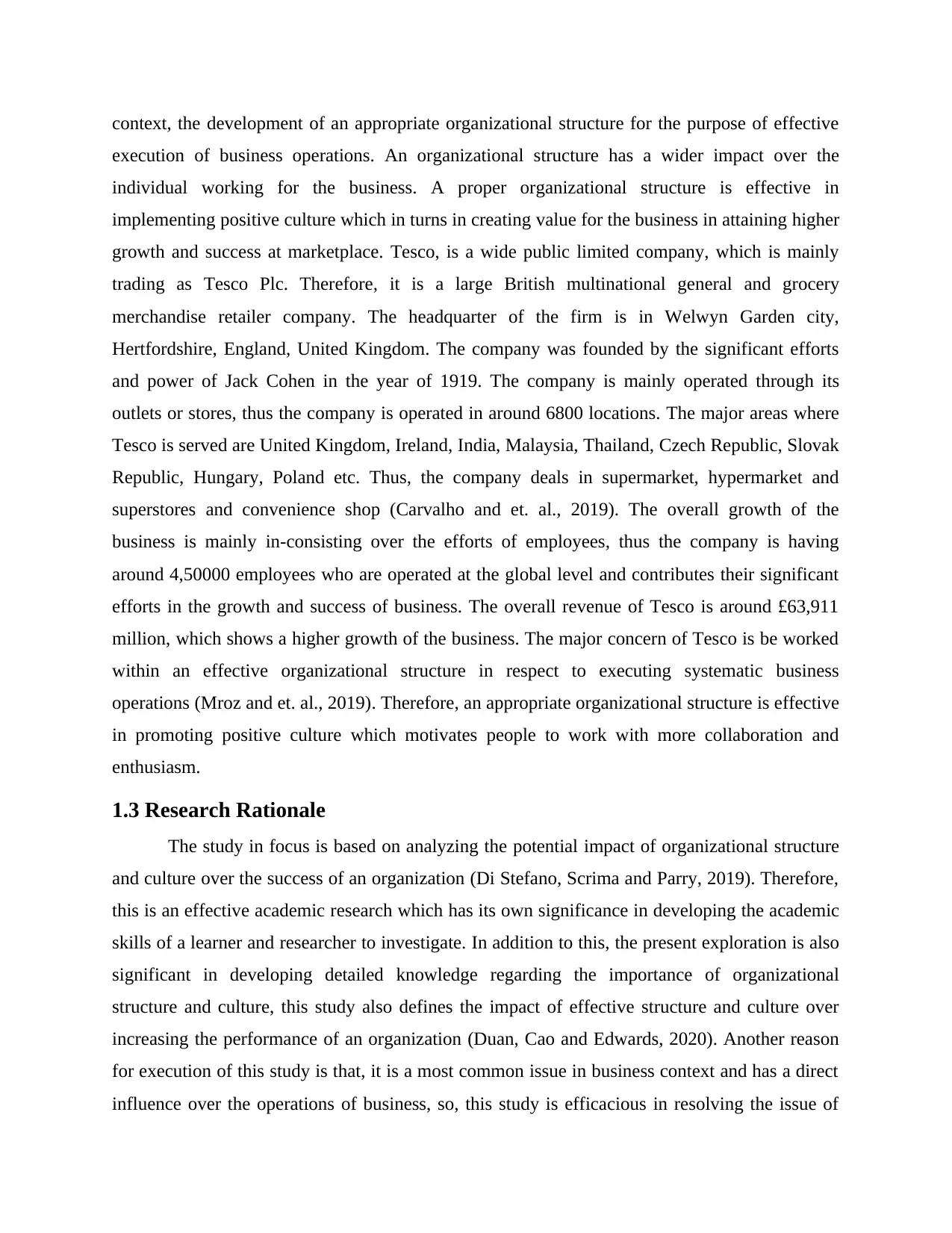
context, the development of an appropriate organizational structure for the purpose of effective
execution of business operations. An organizational structure has a wider impact over the
individual working for the business. A proper organizational structure is effective in
implementing positive culture which in turns in creating value for the business in attaining higher
growth and success at marketplace. Tesco, is a wide public limited company, which is mainly
trading as Tesco Plc. Therefore, it is a large British multinational general and grocery
merchandise retailer company. The headquarter of the firm is in Welwyn Garden city,
Hertfordshire, England, United Kingdom. The company was founded by the significant efforts
and power of Jack Cohen in the year of 1919. The company is mainly operated through its
outlets or stores, thus the company is operated in around 6800 locations. The major areas where
Tesco is served are United Kingdom, Ireland, India, Malaysia, Thailand, Czech Republic, Slovak
Republic, Hungary, Poland etc. Thus, the company deals in supermarket, hypermarket and
superstores and convenience shop (Carvalho and et. al., 2019). The overall growth of the
business is mainly in-consisting over the efforts of employees, thus the company is having
around 4,50000 employees who are operated at the global level and contributes their significant
efforts in the growth and success of business. The overall revenue of Tesco is around £63,911
million, which shows a higher growth of the business. The major concern of Tesco is be worked
within an effective organizational structure in respect to executing systematic business
operations (Mroz and et. al., 2019). Therefore, an appropriate organizational structure is effective
in promoting positive culture which motivates people to work with more collaboration and
enthusiasm.
1.3 Research Rationale
The study in focus is based on analyzing the potential impact of organizational structure
and culture over the success of an organization (Di Stefano, Scrima and Parry, 2019). Therefore,
this is an effective academic research which has its own significance in developing the academic
skills of a learner and researcher to investigate. In addition to this, the present exploration is also
significant in developing detailed knowledge regarding the importance of organizational
structure and culture, this study also defines the impact of effective structure and culture over
increasing the performance of an organization (Duan, Cao and Edwards, 2020). Another reason
for execution of this study is that, it is a most common issue in business context and has a direct
influence over the operations of business, so, this study is efficacious in resolving the issue of
execution of business operations. An organizational structure has a wider impact over the
individual working for the business. A proper organizational structure is effective in
implementing positive culture which in turns in creating value for the business in attaining higher
growth and success at marketplace. Tesco, is a wide public limited company, which is mainly
trading as Tesco Plc. Therefore, it is a large British multinational general and grocery
merchandise retailer company. The headquarter of the firm is in Welwyn Garden city,
Hertfordshire, England, United Kingdom. The company was founded by the significant efforts
and power of Jack Cohen in the year of 1919. The company is mainly operated through its
outlets or stores, thus the company is operated in around 6800 locations. The major areas where
Tesco is served are United Kingdom, Ireland, India, Malaysia, Thailand, Czech Republic, Slovak
Republic, Hungary, Poland etc. Thus, the company deals in supermarket, hypermarket and
superstores and convenience shop (Carvalho and et. al., 2019). The overall growth of the
business is mainly in-consisting over the efforts of employees, thus the company is having
around 4,50000 employees who are operated at the global level and contributes their significant
efforts in the growth and success of business. The overall revenue of Tesco is around £63,911
million, which shows a higher growth of the business. The major concern of Tesco is be worked
within an effective organizational structure in respect to executing systematic business
operations (Mroz and et. al., 2019). Therefore, an appropriate organizational structure is effective
in promoting positive culture which motivates people to work with more collaboration and
enthusiasm.
1.3 Research Rationale
The study in focus is based on analyzing the potential impact of organizational structure
and culture over the success of an organization (Di Stefano, Scrima and Parry, 2019). Therefore,
this is an effective academic research which has its own significance in developing the academic
skills of a learner and researcher to investigate. In addition to this, the present exploration is also
significant in developing detailed knowledge regarding the importance of organizational
structure and culture, this study also defines the impact of effective structure and culture over
increasing the performance of an organization (Duan, Cao and Edwards, 2020). Another reason
for execution of this study is that, it is a most common issue in business context and has a direct
influence over the operations of business, so, this study is efficacious in resolving the issue of
Paraphrase This Document
Need a fresh take? Get an instant paraphrase of this document with our AI Paraphraser
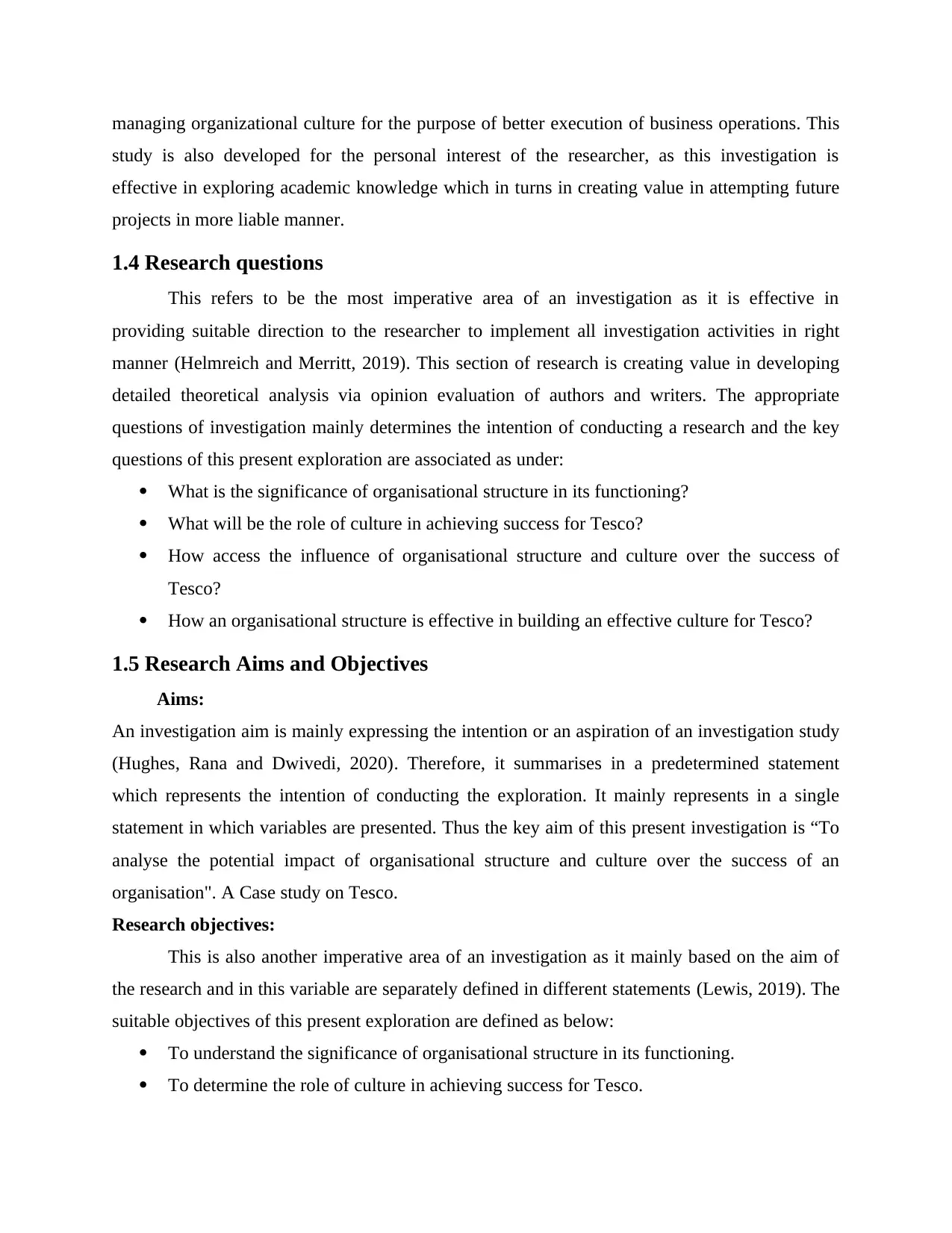
managing organizational culture for the purpose of better execution of business operations. This
study is also developed for the personal interest of the researcher, as this investigation is
effective in exploring academic knowledge which in turns in creating value in attempting future
projects in more liable manner.
1.4 Research questions
This refers to be the most imperative area of an investigation as it is effective in
providing suitable direction to the researcher to implement all investigation activities in right
manner (Helmreich and Merritt, 2019). This section of research is creating value in developing
detailed theoretical analysis via opinion evaluation of authors and writers. The appropriate
questions of investigation mainly determines the intention of conducting a research and the key
questions of this present exploration are associated as under:
What is the significance of organisational structure in its functioning?
What will be the role of culture in achieving success for Tesco?
How access the influence of organisational structure and culture over the success of
Tesco?
How an organisational structure is effective in building an effective culture for Tesco?
1.5 Research Aims and Objectives
Aims:
An investigation aim is mainly expressing the intention or an aspiration of an investigation study
(Hughes, Rana and Dwivedi, 2020). Therefore, it summarises in a predetermined statement
which represents the intention of conducting the exploration. It mainly represents in a single
statement in which variables are presented. Thus the key aim of this present investigation is “To
analyse the potential impact of organisational structure and culture over the success of an
organisation". A Case study on Tesco.
Research objectives:
This is also another imperative area of an investigation as it mainly based on the aim of
the research and in this variable are separately defined in different statements (Lewis, 2019). The
suitable objectives of this present exploration are defined as below:
To understand the significance of organisational structure in its functioning.
To determine the role of culture in achieving success for Tesco.
study is also developed for the personal interest of the researcher, as this investigation is
effective in exploring academic knowledge which in turns in creating value in attempting future
projects in more liable manner.
1.4 Research questions
This refers to be the most imperative area of an investigation as it is effective in
providing suitable direction to the researcher to implement all investigation activities in right
manner (Helmreich and Merritt, 2019). This section of research is creating value in developing
detailed theoretical analysis via opinion evaluation of authors and writers. The appropriate
questions of investigation mainly determines the intention of conducting a research and the key
questions of this present exploration are associated as under:
What is the significance of organisational structure in its functioning?
What will be the role of culture in achieving success for Tesco?
How access the influence of organisational structure and culture over the success of
Tesco?
How an organisational structure is effective in building an effective culture for Tesco?
1.5 Research Aims and Objectives
Aims:
An investigation aim is mainly expressing the intention or an aspiration of an investigation study
(Hughes, Rana and Dwivedi, 2020). Therefore, it summarises in a predetermined statement
which represents the intention of conducting the exploration. It mainly represents in a single
statement in which variables are presented. Thus the key aim of this present investigation is “To
analyse the potential impact of organisational structure and culture over the success of an
organisation". A Case study on Tesco.
Research objectives:
This is also another imperative area of an investigation as it mainly based on the aim of
the research and in this variable are separately defined in different statements (Lewis, 2019). The
suitable objectives of this present exploration are defined as below:
To understand the significance of organisational structure in its functioning.
To determine the role of culture in achieving success for Tesco.
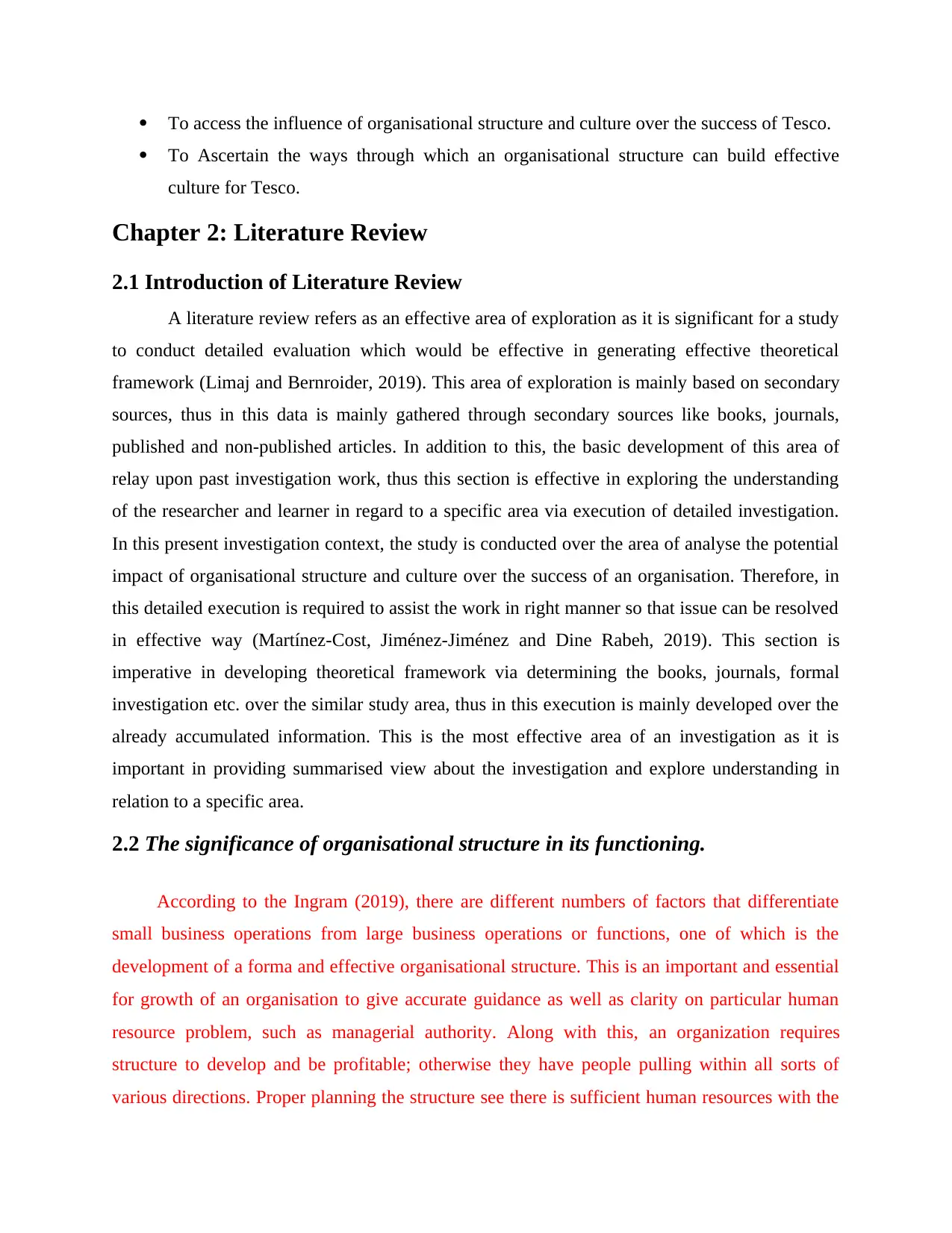
To access the influence of organisational structure and culture over the success of Tesco.
To Ascertain the ways through which an organisational structure can build effective
culture for Tesco.
Chapter 2: Literature Review
2.1 Introduction of Literature Review
A literature review refers as an effective area of exploration as it is significant for a study
to conduct detailed evaluation which would be effective in generating effective theoretical
framework (Limaj and Bernroider, 2019). This area of exploration is mainly based on secondary
sources, thus in this data is mainly gathered through secondary sources like books, journals,
published and non-published articles. In addition to this, the basic development of this area of
relay upon past investigation work, thus this section is effective in exploring the understanding
of the researcher and learner in regard to a specific area via execution of detailed investigation.
In this present investigation context, the study is conducted over the area of analyse the potential
impact of organisational structure and culture over the success of an organisation. Therefore, in
this detailed execution is required to assist the work in right manner so that issue can be resolved
in effective way (Martínez-Cost, Jiménez-Jiménez and Dine Rabeh, 2019). This section is
imperative in developing theoretical framework via determining the books, journals, formal
investigation etc. over the similar study area, thus in this execution is mainly developed over the
already accumulated information. This is the most effective area of an investigation as it is
important in providing summarised view about the investigation and explore understanding in
relation to a specific area.
2.2 The significance of organisational structure in its functioning.
According to the Ingram (2019), there are different numbers of factors that differentiate
small business operations from large business operations or functions, one of which is the
development of a forma and effective organisational structure. This is an important and essential
for growth of an organisation to give accurate guidance as well as clarity on particular human
resource problem, such as managerial authority. Along with this, an organization requires
structure to develop and be profitable; otherwise they have people pulling within all sorts of
various directions. Proper planning the structure see there is sufficient human resources with the
To Ascertain the ways through which an organisational structure can build effective
culture for Tesco.
Chapter 2: Literature Review
2.1 Introduction of Literature Review
A literature review refers as an effective area of exploration as it is significant for a study
to conduct detailed evaluation which would be effective in generating effective theoretical
framework (Limaj and Bernroider, 2019). This area of exploration is mainly based on secondary
sources, thus in this data is mainly gathered through secondary sources like books, journals,
published and non-published articles. In addition to this, the basic development of this area of
relay upon past investigation work, thus this section is effective in exploring the understanding
of the researcher and learner in regard to a specific area via execution of detailed investigation.
In this present investigation context, the study is conducted over the area of analyse the potential
impact of organisational structure and culture over the success of an organisation. Therefore, in
this detailed execution is required to assist the work in right manner so that issue can be resolved
in effective way (Martínez-Cost, Jiménez-Jiménez and Dine Rabeh, 2019). This section is
imperative in developing theoretical framework via determining the books, journals, formal
investigation etc. over the similar study area, thus in this execution is mainly developed over the
already accumulated information. This is the most effective area of an investigation as it is
important in providing summarised view about the investigation and explore understanding in
relation to a specific area.
2.2 The significance of organisational structure in its functioning.
According to the Ingram (2019), there are different numbers of factors that differentiate
small business operations from large business operations or functions, one of which is the
development of a forma and effective organisational structure. This is an important and essential
for growth of an organisation to give accurate guidance as well as clarity on particular human
resource problem, such as managerial authority. Along with this, an organization requires
structure to develop and be profitable; otherwise they have people pulling within all sorts of
various directions. Proper planning the structure see there is sufficient human resources with the
⊘ This is a preview!⊘
Do you want full access?
Subscribe today to unlock all pages.

Trusted by 1+ million students worldwide
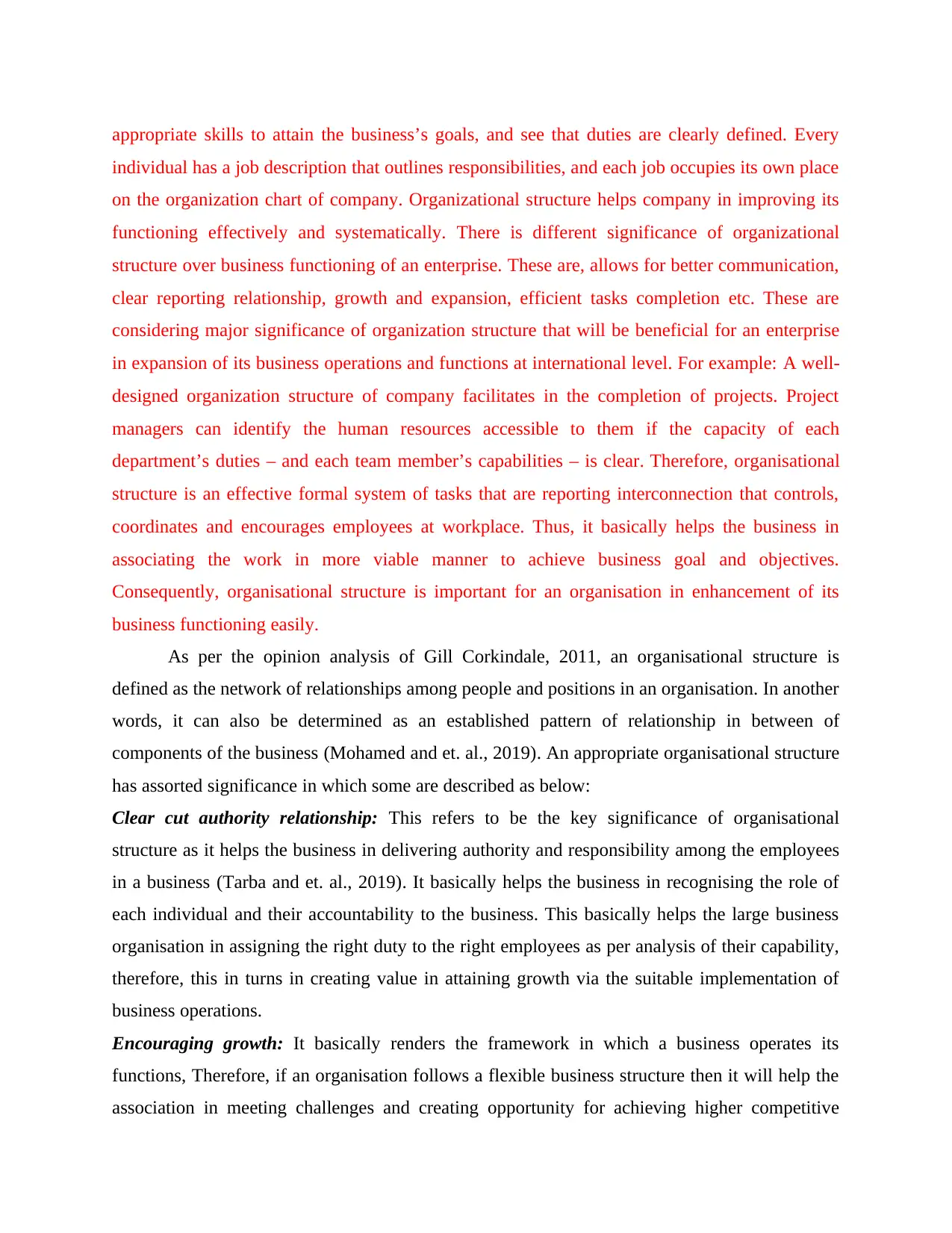
appropriate skills to attain the business’s goals, and see that duties are clearly defined. Every
individual has a job description that outlines responsibilities, and each job occupies its own place
on the organization chart of company. Organizational structure helps company in improving its
functioning effectively and systematically. There is different significance of organizational
structure over business functioning of an enterprise. These are, allows for better communication,
clear reporting relationship, growth and expansion, efficient tasks completion etc. These are
considering major significance of organization structure that will be beneficial for an enterprise
in expansion of its business operations and functions at international level. For example: A well-
designed organization structure of company facilitates in the completion of projects. Project
managers can identify the human resources accessible to them if the capacity of each
department’s duties – and each team member’s capabilities – is clear. Therefore, organisational
structure is an effective formal system of tasks that are reporting interconnection that controls,
coordinates and encourages employees at workplace. Thus, it basically helps the business in
associating the work in more viable manner to achieve business goal and objectives.
Consequently, organisational structure is important for an organisation in enhancement of its
business functioning easily.
As per the opinion analysis of Gill Corkindale, 2011, an organisational structure is
defined as the network of relationships among people and positions in an organisation. In another
words, it can also be determined as an established pattern of relationship in between of
components of the business (Mohamed and et. al., 2019). An appropriate organisational structure
has assorted significance in which some are described as below:
Clear cut authority relationship: This refers to be the key significance of organisational
structure as it helps the business in delivering authority and responsibility among the employees
in a business (Tarba and et. al., 2019). It basically helps the business in recognising the role of
each individual and their accountability to the business. This basically helps the large business
organisation in assigning the right duty to the right employees as per analysis of their capability,
therefore, this in turns in creating value in attaining growth via the suitable implementation of
business operations.
Encouraging growth: It basically renders the framework in which a business operates its
functions, Therefore, if an organisation follows a flexible business structure then it will help the
association in meeting challenges and creating opportunity for achieving higher competitive
individual has a job description that outlines responsibilities, and each job occupies its own place
on the organization chart of company. Organizational structure helps company in improving its
functioning effectively and systematically. There is different significance of organizational
structure over business functioning of an enterprise. These are, allows for better communication,
clear reporting relationship, growth and expansion, efficient tasks completion etc. These are
considering major significance of organization structure that will be beneficial for an enterprise
in expansion of its business operations and functions at international level. For example: A well-
designed organization structure of company facilitates in the completion of projects. Project
managers can identify the human resources accessible to them if the capacity of each
department’s duties – and each team member’s capabilities – is clear. Therefore, organisational
structure is an effective formal system of tasks that are reporting interconnection that controls,
coordinates and encourages employees at workplace. Thus, it basically helps the business in
associating the work in more viable manner to achieve business goal and objectives.
Consequently, organisational structure is important for an organisation in enhancement of its
business functioning easily.
As per the opinion analysis of Gill Corkindale, 2011, an organisational structure is
defined as the network of relationships among people and positions in an organisation. In another
words, it can also be determined as an established pattern of relationship in between of
components of the business (Mohamed and et. al., 2019). An appropriate organisational structure
has assorted significance in which some are described as below:
Clear cut authority relationship: This refers to be the key significance of organisational
structure as it helps the business in delivering authority and responsibility among the employees
in a business (Tarba and et. al., 2019). It basically helps the business in recognising the role of
each individual and their accountability to the business. This basically helps the large business
organisation in assigning the right duty to the right employees as per analysis of their capability,
therefore, this in turns in creating value in attaining growth via the suitable implementation of
business operations.
Encouraging growth: It basically renders the framework in which a business operates its
functions, Therefore, if an organisation follows a flexible business structure then it will help the
association in meeting challenges and creating opportunity for achieving higher competitive
Paraphrase This Document
Need a fresh take? Get an instant paraphrase of this document with our AI Paraphraser
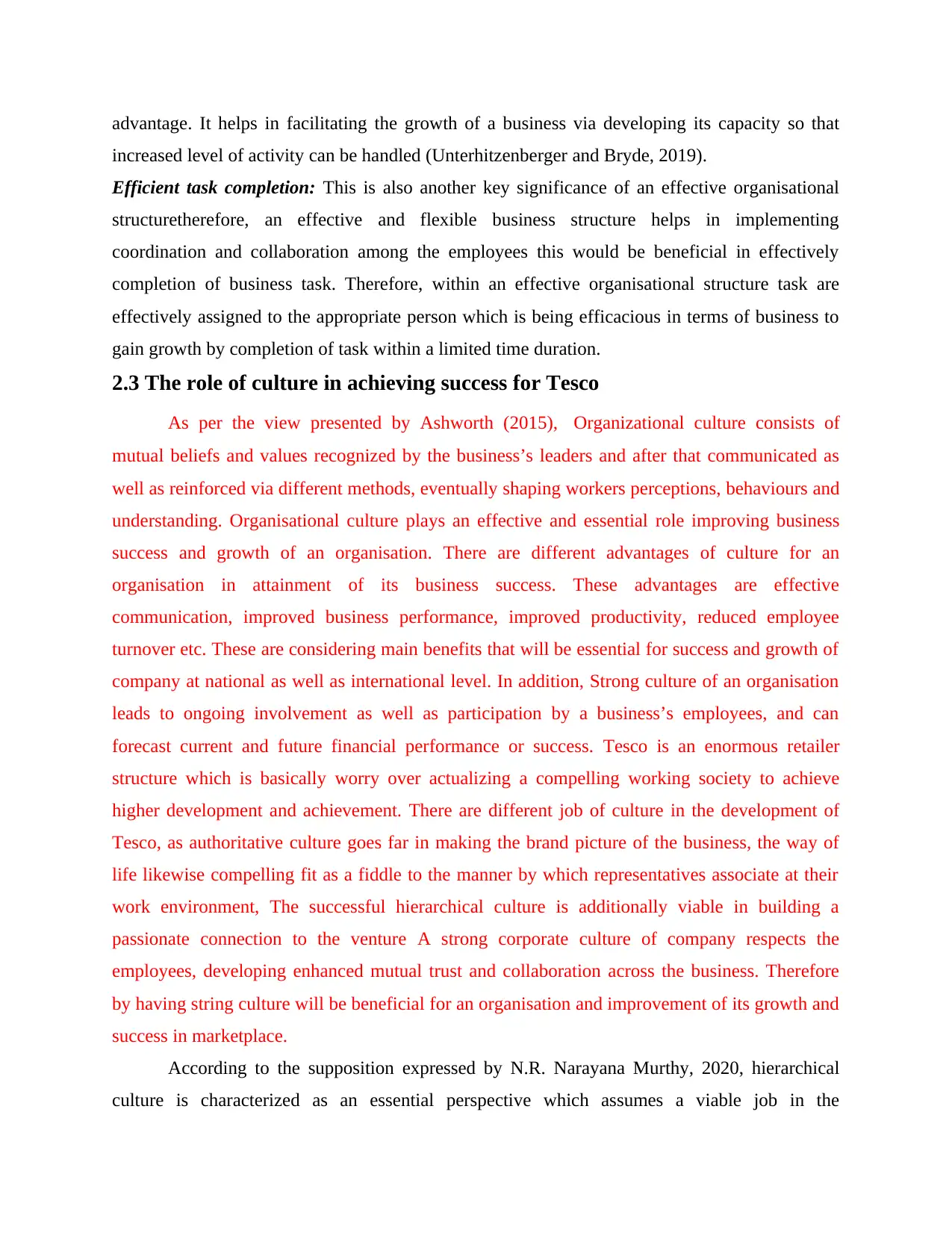
advantage. It helps in facilitating the growth of a business via developing its capacity so that
increased level of activity can be handled (Unterhitzenberger and Bryde, 2019).
Efficient task completion: This is also another key significance of an effective organisational
structuretherefore, an effective and flexible business structure helps in implementing
coordination and collaboration among the employees this would be beneficial in effectively
completion of business task. Therefore, within an effective organisational structure task are
effectively assigned to the appropriate person which is being efficacious in terms of business to
gain growth by completion of task within a limited time duration.
2.3 The role of culture in achieving success for Tesco
As per the view presented by Ashworth (2015), Organizational culture consists of
mutual beliefs and values recognized by the business’s leaders and after that communicated as
well as reinforced via different methods, eventually shaping workers perceptions, behaviours and
understanding. Organisational culture plays an effective and essential role improving business
success and growth of an organisation. There are different advantages of culture for an
organisation in attainment of its business success. These advantages are effective
communication, improved business performance, improved productivity, reduced employee
turnover etc. These are considering main benefits that will be essential for success and growth of
company at national as well as international level. In addition, Strong culture of an organisation
leads to ongoing involvement as well as participation by a business’s employees, and can
forecast current and future financial performance or success. Tesco is an enormous retailer
structure which is basically worry over actualizing a compelling working society to achieve
higher development and achievement. There are different job of culture in the development of
Tesco, as authoritative culture goes far in making the brand picture of the business, the way of
life likewise compelling fit as a fiddle to the manner by which representatives associate at their
work environment, The successful hierarchical culture is additionally viable in building a
passionate connection to the venture A strong corporate culture of company respects the
employees, developing enhanced mutual trust and collaboration across the business. Therefore
by having string culture will be beneficial for an organisation and improvement of its growth and
success in marketplace.
According to the supposition expressed by N.R. Narayana Murthy, 2020, hierarchical
culture is characterized as an essential perspective which assumes a viable job in the
increased level of activity can be handled (Unterhitzenberger and Bryde, 2019).
Efficient task completion: This is also another key significance of an effective organisational
structuretherefore, an effective and flexible business structure helps in implementing
coordination and collaboration among the employees this would be beneficial in effectively
completion of business task. Therefore, within an effective organisational structure task are
effectively assigned to the appropriate person which is being efficacious in terms of business to
gain growth by completion of task within a limited time duration.
2.3 The role of culture in achieving success for Tesco
As per the view presented by Ashworth (2015), Organizational culture consists of
mutual beliefs and values recognized by the business’s leaders and after that communicated as
well as reinforced via different methods, eventually shaping workers perceptions, behaviours and
understanding. Organisational culture plays an effective and essential role improving business
success and growth of an organisation. There are different advantages of culture for an
organisation in attainment of its business success. These advantages are effective
communication, improved business performance, improved productivity, reduced employee
turnover etc. These are considering main benefits that will be essential for success and growth of
company at national as well as international level. In addition, Strong culture of an organisation
leads to ongoing involvement as well as participation by a business’s employees, and can
forecast current and future financial performance or success. Tesco is an enormous retailer
structure which is basically worry over actualizing a compelling working society to achieve
higher development and achievement. There are different job of culture in the development of
Tesco, as authoritative culture goes far in making the brand picture of the business, the way of
life likewise compelling fit as a fiddle to the manner by which representatives associate at their
work environment, The successful hierarchical culture is additionally viable in building a
passionate connection to the venture A strong corporate culture of company respects the
employees, developing enhanced mutual trust and collaboration across the business. Therefore
by having string culture will be beneficial for an organisation and improvement of its growth and
success in marketplace.
According to the supposition expressed by N.R. Narayana Murthy, 2020, hierarchical
culture is characterized as an essential perspective which assumes a viable job in the
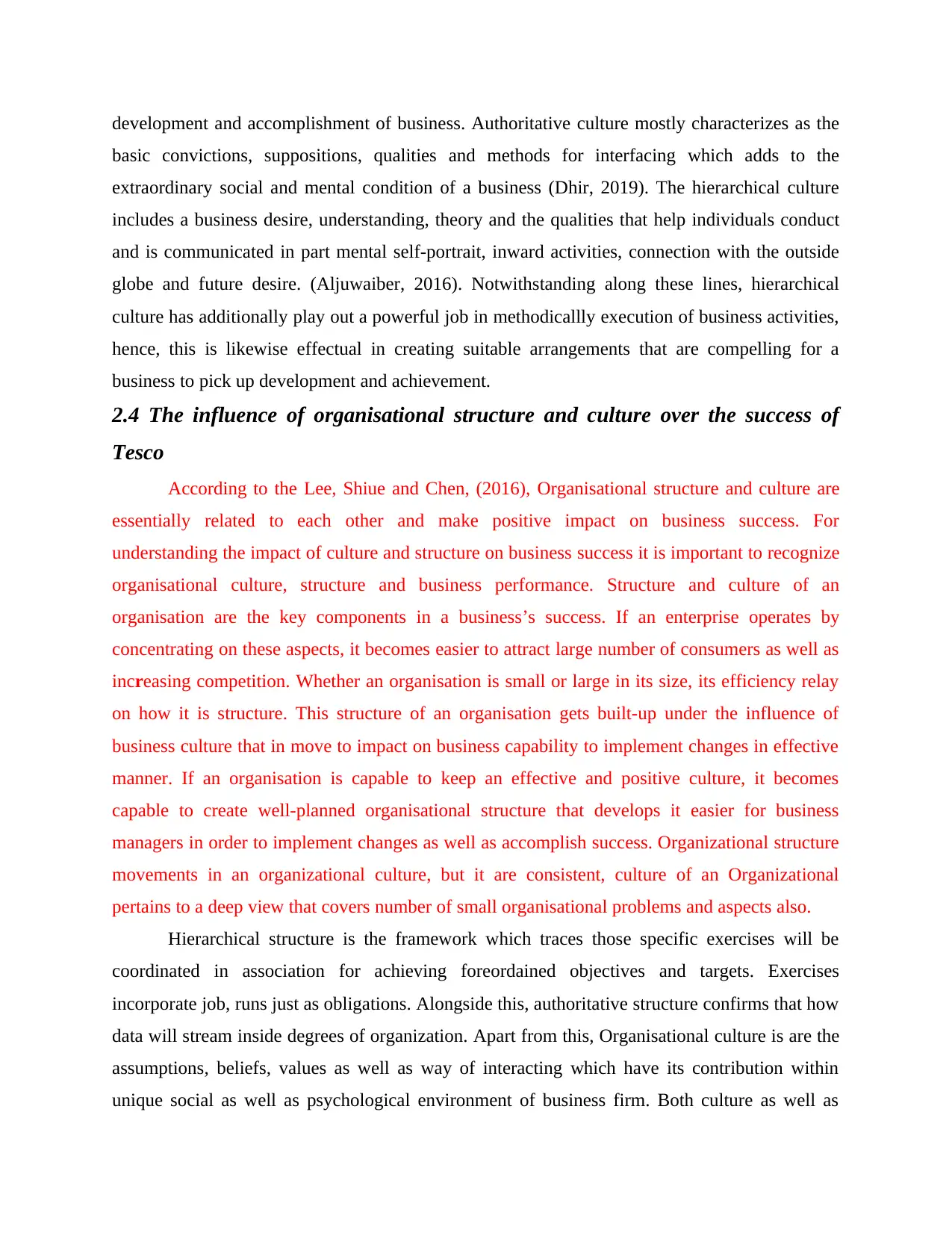
development and accomplishment of business. Authoritative culture mostly characterizes as the
basic convictions, suppositions, qualities and methods for interfacing which adds to the
extraordinary social and mental condition of a business (Dhir, 2019). The hierarchical culture
includes a business desire, understanding, theory and the qualities that help individuals conduct
and is communicated in part mental self-portrait, inward activities, connection with the outside
globe and future desire. (Aljuwaiber, 2016). Notwithstanding along these lines, hierarchical
culture has additionally play out a powerful job in methodicallly execution of business activities,
hence, this is likewise effectual in creating suitable arrangements that are compelling for a
business to pick up development and achievement.
2.4 The influence of organisational structure and culture over the success of
Tesco
According to the Lee, Shiue and Chen, (2016), Organisational structure and culture are
essentially related to each other and make positive impact on business success. For
understanding the impact of culture and structure on business success it is important to recognize
organisational culture, structure and business performance. Structure and culture of an
organisation are the key components in a business’s success. If an enterprise operates by
concentrating on these aspects, it becomes easier to attract large number of consumers as well as
increasing competition. Whether an organisation is small or large in its size, its efficiency relay
on how it is structure. This structure of an organisation gets built-up under the influence of
business culture that in move to impact on business capability to implement changes in effective
manner. If an organisation is capable to keep an effective and positive culture, it becomes
capable to create well-planned organisational structure that develops it easier for business
managers in order to implement changes as well as accomplish success. Organizational structure
movements in an organizational culture, but it are consistent, culture of an Organizational
pertains to a deep view that covers number of small organisational problems and aspects also.
Hierarchical structure is the framework which traces those specific exercises will be
coordinated in association for achieving foreordained objectives and targets. Exercises
incorporate job, runs just as obligations. Alongside this, authoritative structure confirms that how
data will stream inside degrees of organization. Apart from this, Organisational culture is are the
assumptions, beliefs, values as well as way of interacting which have its contribution within
unique social as well as psychological environment of business firm. Both culture as well as
basic convictions, suppositions, qualities and methods for interfacing which adds to the
extraordinary social and mental condition of a business (Dhir, 2019). The hierarchical culture
includes a business desire, understanding, theory and the qualities that help individuals conduct
and is communicated in part mental self-portrait, inward activities, connection with the outside
globe and future desire. (Aljuwaiber, 2016). Notwithstanding along these lines, hierarchical
culture has additionally play out a powerful job in methodicallly execution of business activities,
hence, this is likewise effectual in creating suitable arrangements that are compelling for a
business to pick up development and achievement.
2.4 The influence of organisational structure and culture over the success of
Tesco
According to the Lee, Shiue and Chen, (2016), Organisational structure and culture are
essentially related to each other and make positive impact on business success. For
understanding the impact of culture and structure on business success it is important to recognize
organisational culture, structure and business performance. Structure and culture of an
organisation are the key components in a business’s success. If an enterprise operates by
concentrating on these aspects, it becomes easier to attract large number of consumers as well as
increasing competition. Whether an organisation is small or large in its size, its efficiency relay
on how it is structure. This structure of an organisation gets built-up under the influence of
business culture that in move to impact on business capability to implement changes in effective
manner. If an organisation is capable to keep an effective and positive culture, it becomes
capable to create well-planned organisational structure that develops it easier for business
managers in order to implement changes as well as accomplish success. Organizational structure
movements in an organizational culture, but it are consistent, culture of an Organizational
pertains to a deep view that covers number of small organisational problems and aspects also.
Hierarchical structure is the framework which traces those specific exercises will be
coordinated in association for achieving foreordained objectives and targets. Exercises
incorporate job, runs just as obligations. Alongside this, authoritative structure confirms that how
data will stream inside degrees of organization. Apart from this, Organisational culture is are the
assumptions, beliefs, values as well as way of interacting which have its contribution within
unique social as well as psychological environment of business firm. Both culture as well as
⊘ This is a preview!⊘
Do you want full access?
Subscribe today to unlock all pages.

Trusted by 1+ million students worldwide
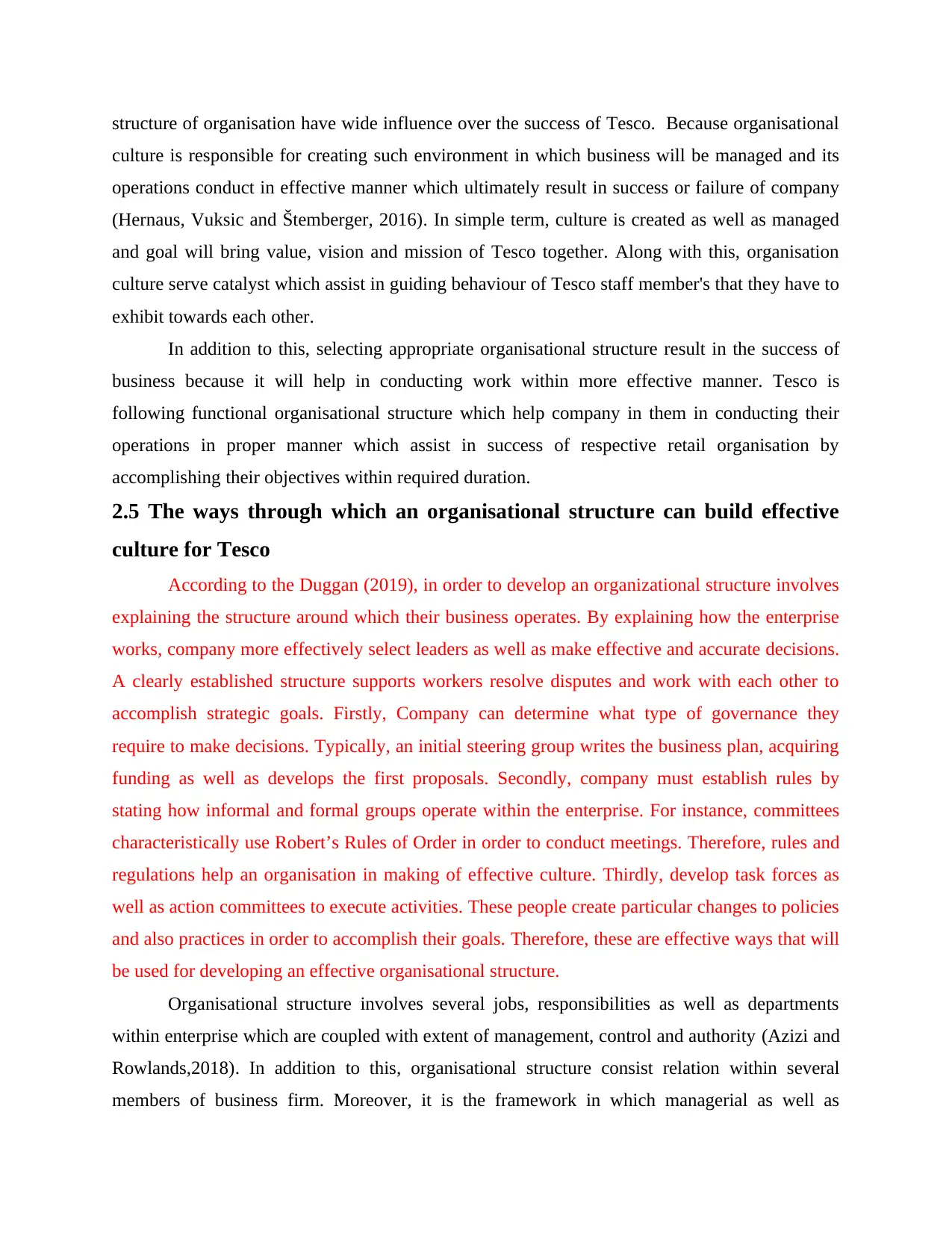
structure of organisation have wide influence over the success of Tesco. Because organisational
culture is responsible for creating such environment in which business will be managed and its
operations conduct in effective manner which ultimately result in success or failure of company
(Hernaus, Vuksic and Štemberger, 2016). In simple term, culture is created as well as managed
and goal will bring value, vision and mission of Tesco together. Along with this, organisation
culture serve catalyst which assist in guiding behaviour of Tesco staff member's that they have to
exhibit towards each other.
In addition to this, selecting appropriate organisational structure result in the success of
business because it will help in conducting work within more effective manner. Tesco is
following functional organisational structure which help company in them in conducting their
operations in proper manner which assist in success of respective retail organisation by
accomplishing their objectives within required duration.
2.5 The ways through which an organisational structure can build effective
culture for Tesco
According to the Duggan (2019), in order to develop an organizational structure involves
explaining the structure around which their business operates. By explaining how the enterprise
works, company more effectively select leaders as well as make effective and accurate decisions.
A clearly established structure supports workers resolve disputes and work with each other to
accomplish strategic goals. Firstly, Company can determine what type of governance they
require to make decisions. Typically, an initial steering group writes the business plan, acquiring
funding as well as develops the first proposals. Secondly, company must establish rules by
stating how informal and formal groups operate within the enterprise. For instance, committees
characteristically use Robert’s Rules of Order in order to conduct meetings. Therefore, rules and
regulations help an organisation in making of effective culture. Thirdly, develop task forces as
well as action committees to execute activities. These people create particular changes to policies
and also practices in order to accomplish their goals. Therefore, these are effective ways that will
be used for developing an effective organisational structure.
Organisational structure involves several jobs, responsibilities as well as departments
within enterprise which are coupled with extent of management, control and authority (Azizi and
Rowlands,2018). In addition to this, organisational structure consist relation within several
members of business firm. Moreover, it is the framework in which managerial as well as
culture is responsible for creating such environment in which business will be managed and its
operations conduct in effective manner which ultimately result in success or failure of company
(Hernaus, Vuksic and Štemberger, 2016). In simple term, culture is created as well as managed
and goal will bring value, vision and mission of Tesco together. Along with this, organisation
culture serve catalyst which assist in guiding behaviour of Tesco staff member's that they have to
exhibit towards each other.
In addition to this, selecting appropriate organisational structure result in the success of
business because it will help in conducting work within more effective manner. Tesco is
following functional organisational structure which help company in them in conducting their
operations in proper manner which assist in success of respective retail organisation by
accomplishing their objectives within required duration.
2.5 The ways through which an organisational structure can build effective
culture for Tesco
According to the Duggan (2019), in order to develop an organizational structure involves
explaining the structure around which their business operates. By explaining how the enterprise
works, company more effectively select leaders as well as make effective and accurate decisions.
A clearly established structure supports workers resolve disputes and work with each other to
accomplish strategic goals. Firstly, Company can determine what type of governance they
require to make decisions. Typically, an initial steering group writes the business plan, acquiring
funding as well as develops the first proposals. Secondly, company must establish rules by
stating how informal and formal groups operate within the enterprise. For instance, committees
characteristically use Robert’s Rules of Order in order to conduct meetings. Therefore, rules and
regulations help an organisation in making of effective culture. Thirdly, develop task forces as
well as action committees to execute activities. These people create particular changes to policies
and also practices in order to accomplish their goals. Therefore, these are effective ways that will
be used for developing an effective organisational structure.
Organisational structure involves several jobs, responsibilities as well as departments
within enterprise which are coupled with extent of management, control and authority (Azizi and
Rowlands,2018). In addition to this, organisational structure consist relation within several
members of business firm. Moreover, it is the framework in which managerial as well as
Paraphrase This Document
Need a fresh take? Get an instant paraphrase of this document with our AI Paraphraser
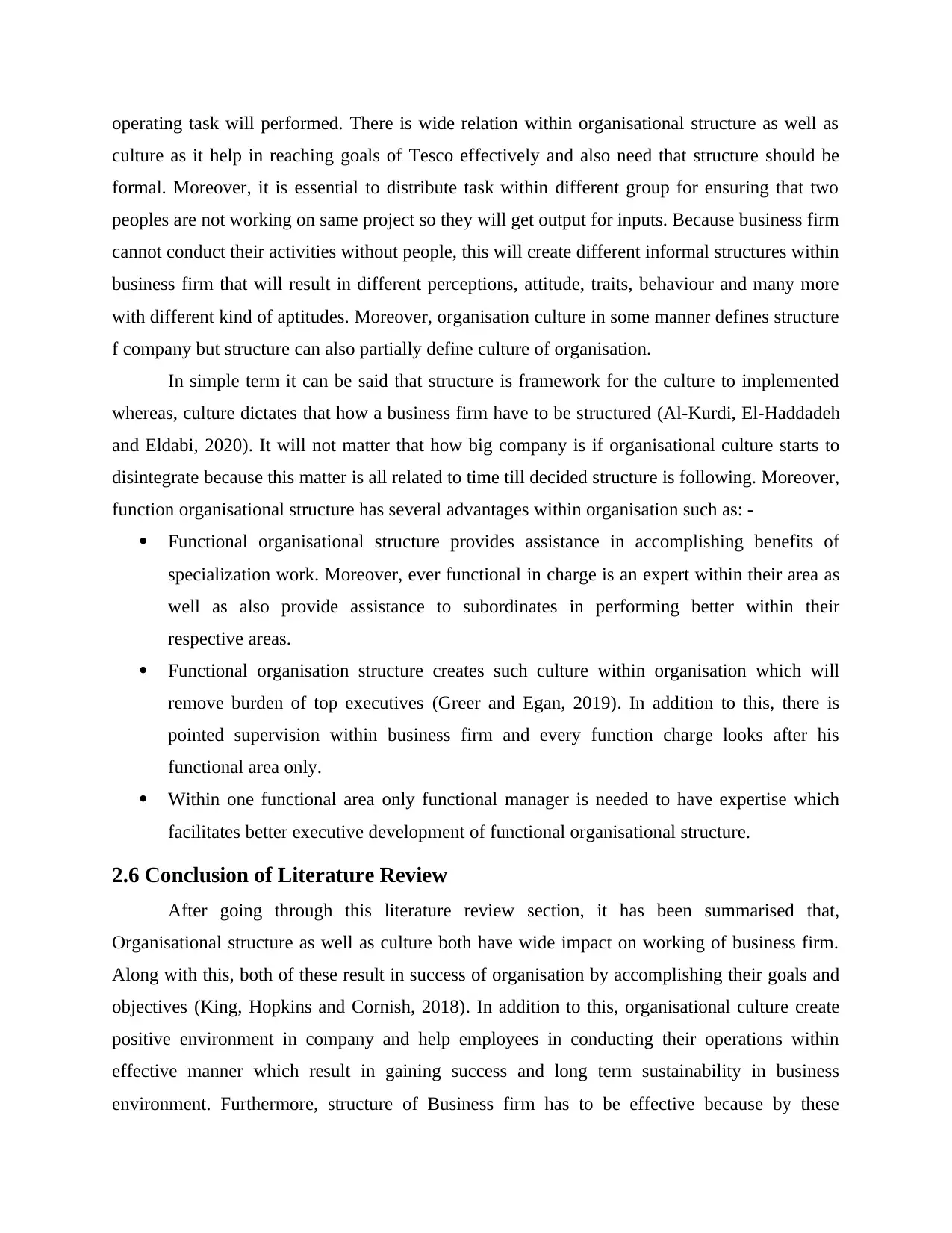
operating task will performed. There is wide relation within organisational structure as well as
culture as it help in reaching goals of Tesco effectively and also need that structure should be
formal. Moreover, it is essential to distribute task within different group for ensuring that two
peoples are not working on same project so they will get output for inputs. Because business firm
cannot conduct their activities without people, this will create different informal structures within
business firm that will result in different perceptions, attitude, traits, behaviour and many more
with different kind of aptitudes. Moreover, organisation culture in some manner defines structure
f company but structure can also partially define culture of organisation.
In simple term it can be said that structure is framework for the culture to implemented
whereas, culture dictates that how a business firm have to be structured (Al-Kurdi, El-Haddadeh
and Eldabi, 2020). It will not matter that how big company is if organisational culture starts to
disintegrate because this matter is all related to time till decided structure is following. Moreover,
function organisational structure has several advantages within organisation such as: -
Functional organisational structure provides assistance in accomplishing benefits of
specialization work. Moreover, ever functional in charge is an expert within their area as
well as also provide assistance to subordinates in performing better within their
respective areas.
Functional organisation structure creates such culture within organisation which will
remove burden of top executives (Greer and Egan, 2019). In addition to this, there is
pointed supervision within business firm and every function charge looks after his
functional area only.
Within one functional area only functional manager is needed to have expertise which
facilitates better executive development of functional organisational structure.
2.6 Conclusion of Literature Review
After going through this literature review section, it has been summarised that,
Organisational structure as well as culture both have wide impact on working of business firm.
Along with this, both of these result in success of organisation by accomplishing their goals and
objectives (King, Hopkins and Cornish, 2018). In addition to this, organisational culture create
positive environment in company and help employees in conducting their operations within
effective manner which result in gaining success and long term sustainability in business
environment. Furthermore, structure of Business firm has to be effective because by these
culture as it help in reaching goals of Tesco effectively and also need that structure should be
formal. Moreover, it is essential to distribute task within different group for ensuring that two
peoples are not working on same project so they will get output for inputs. Because business firm
cannot conduct their activities without people, this will create different informal structures within
business firm that will result in different perceptions, attitude, traits, behaviour and many more
with different kind of aptitudes. Moreover, organisation culture in some manner defines structure
f company but structure can also partially define culture of organisation.
In simple term it can be said that structure is framework for the culture to implemented
whereas, culture dictates that how a business firm have to be structured (Al-Kurdi, El-Haddadeh
and Eldabi, 2020). It will not matter that how big company is if organisational culture starts to
disintegrate because this matter is all related to time till decided structure is following. Moreover,
function organisational structure has several advantages within organisation such as: -
Functional organisational structure provides assistance in accomplishing benefits of
specialization work. Moreover, ever functional in charge is an expert within their area as
well as also provide assistance to subordinates in performing better within their
respective areas.
Functional organisation structure creates such culture within organisation which will
remove burden of top executives (Greer and Egan, 2019). In addition to this, there is
pointed supervision within business firm and every function charge looks after his
functional area only.
Within one functional area only functional manager is needed to have expertise which
facilitates better executive development of functional organisational structure.
2.6 Conclusion of Literature Review
After going through this literature review section, it has been summarised that,
Organisational structure as well as culture both have wide impact on working of business firm.
Along with this, both of these result in success of organisation by accomplishing their goals and
objectives (King, Hopkins and Cornish, 2018). In addition to this, organisational culture create
positive environment in company and help employees in conducting their operations within
effective manner which result in gaining success and long term sustainability in business
environment. Furthermore, structure of Business firm has to be effective because by these
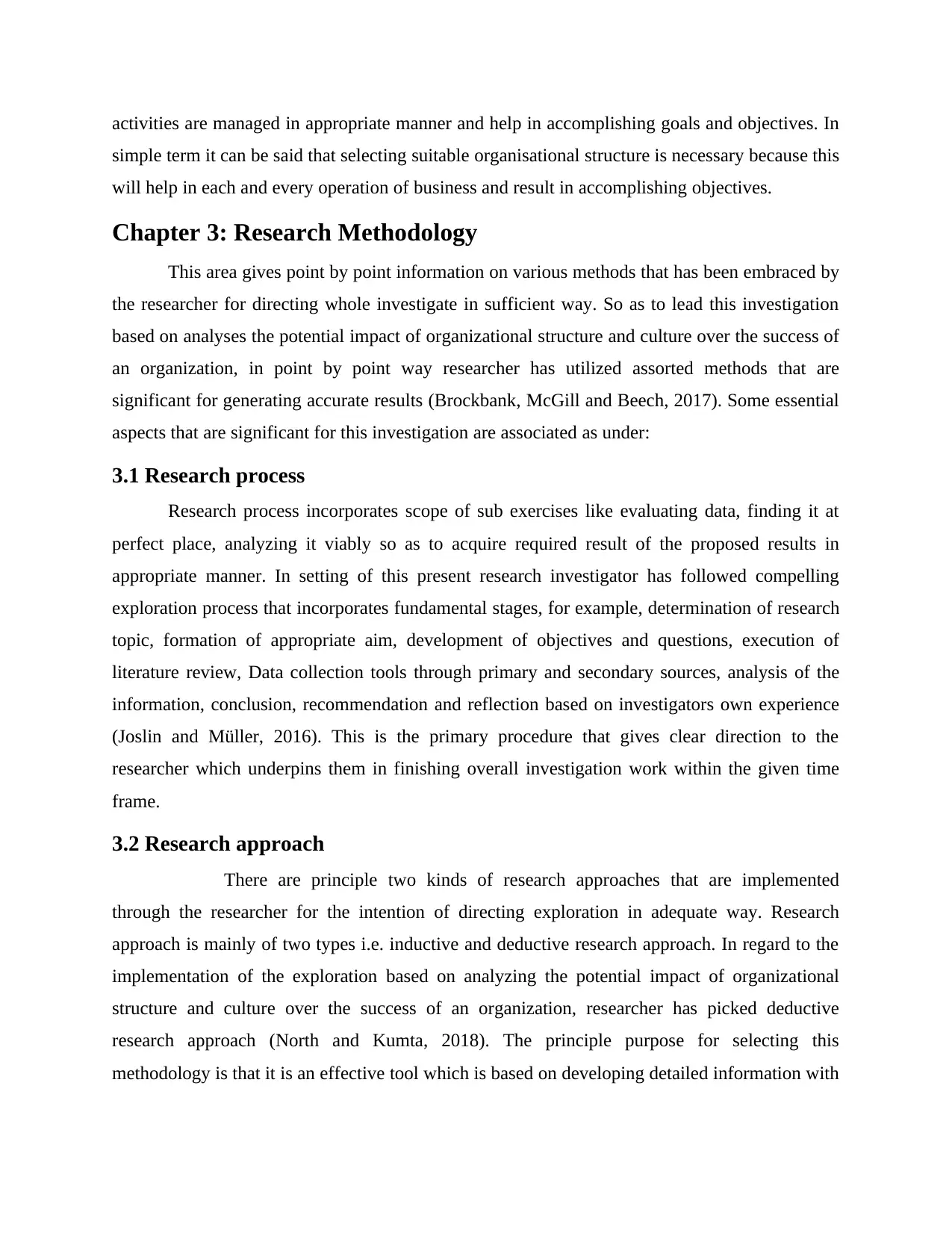
activities are managed in appropriate manner and help in accomplishing goals and objectives. In
simple term it can be said that selecting suitable organisational structure is necessary because this
will help in each and every operation of business and result in accomplishing objectives.
Chapter 3: Research Methodology
This area gives point by point information on various methods that has been embraced by
the researcher for directing whole investigate in sufficient way. So as to lead this investigation
based on analyses the potential impact of organizational structure and culture over the success of
an organization, in point by point way researcher has utilized assorted methods that are
significant for generating accurate results (Brockbank, McGill and Beech, 2017). Some essential
aspects that are significant for this investigation are associated as under:
3.1 Research process
Research process incorporates scope of sub exercises like evaluating data, finding it at
perfect place, analyzing it viably so as to acquire required result of the proposed results in
appropriate manner. In setting of this present research investigator has followed compelling
exploration process that incorporates fundamental stages, for example, determination of research
topic, formation of appropriate aim, development of objectives and questions, execution of
literature review, Data collection tools through primary and secondary sources, analysis of the
information, conclusion, recommendation and reflection based on investigators own experience
(Joslin and Müller, 2016). This is the primary procedure that gives clear direction to the
researcher which underpins them in finishing overall investigation work within the given time
frame.
3.2 Research approach
There are principle two kinds of research approaches that are implemented
through the researcher for the intention of directing exploration in adequate way. Research
approach is mainly of two types i.e. inductive and deductive research approach. In regard to the
implementation of the exploration based on analyzing the potential impact of organizational
structure and culture over the success of an organization, researcher has picked deductive
research approach (North and Kumta, 2018). The principle purpose for selecting this
methodology is that it is an effective tool which is based on developing detailed information with
simple term it can be said that selecting suitable organisational structure is necessary because this
will help in each and every operation of business and result in accomplishing objectives.
Chapter 3: Research Methodology
This area gives point by point information on various methods that has been embraced by
the researcher for directing whole investigate in sufficient way. So as to lead this investigation
based on analyses the potential impact of organizational structure and culture over the success of
an organization, in point by point way researcher has utilized assorted methods that are
significant for generating accurate results (Brockbank, McGill and Beech, 2017). Some essential
aspects that are significant for this investigation are associated as under:
3.1 Research process
Research process incorporates scope of sub exercises like evaluating data, finding it at
perfect place, analyzing it viably so as to acquire required result of the proposed results in
appropriate manner. In setting of this present research investigator has followed compelling
exploration process that incorporates fundamental stages, for example, determination of research
topic, formation of appropriate aim, development of objectives and questions, execution of
literature review, Data collection tools through primary and secondary sources, analysis of the
information, conclusion, recommendation and reflection based on investigators own experience
(Joslin and Müller, 2016). This is the primary procedure that gives clear direction to the
researcher which underpins them in finishing overall investigation work within the given time
frame.
3.2 Research approach
There are principle two kinds of research approaches that are implemented
through the researcher for the intention of directing exploration in adequate way. Research
approach is mainly of two types i.e. inductive and deductive research approach. In regard to the
implementation of the exploration based on analyzing the potential impact of organizational
structure and culture over the success of an organization, researcher has picked deductive
research approach (North and Kumta, 2018). The principle purpose for selecting this
methodology is that it is an effective tool which is based on developing detailed information with
⊘ This is a preview!⊘
Do you want full access?
Subscribe today to unlock all pages.

Trusted by 1+ million students worldwide
1 out of 37
Related Documents
Your All-in-One AI-Powered Toolkit for Academic Success.
+13062052269
info@desklib.com
Available 24*7 on WhatsApp / Email
![[object Object]](/_next/static/media/star-bottom.7253800d.svg)
Unlock your academic potential
Copyright © 2020–2025 A2Z Services. All Rights Reserved. Developed and managed by ZUCOL.





